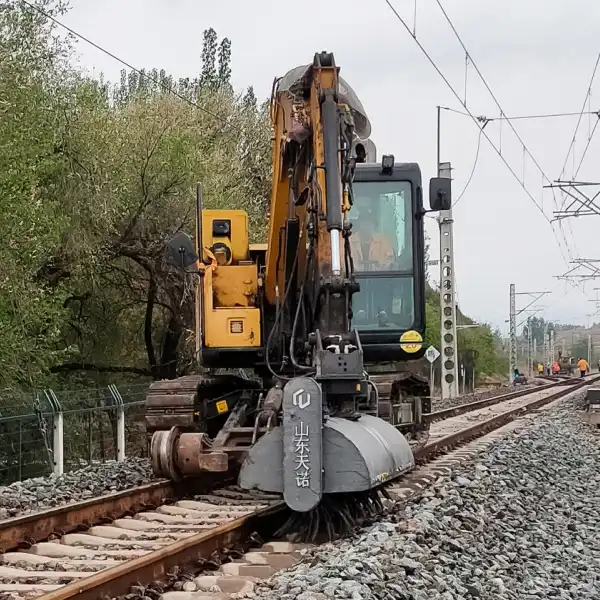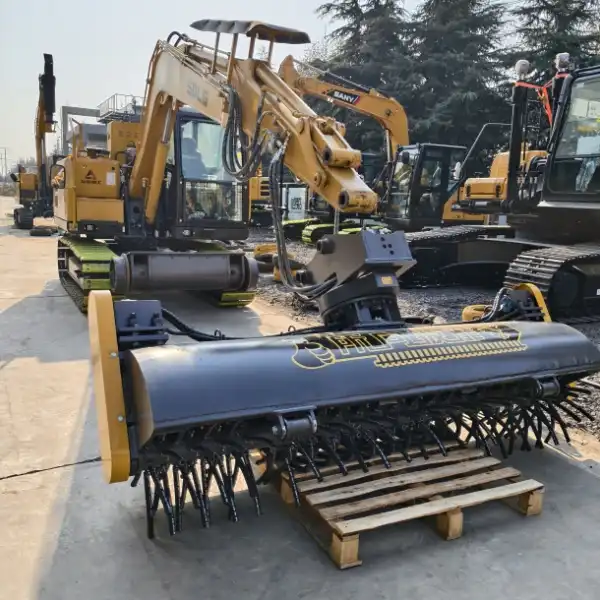Is railway track sweeper easy to attach to excavator?
Absolutely, attaching a railway track sweeper to an excavator is designed to be straightforward and user-friendly for most operators. Modern track sweeping attachments feature universal mounting systems that accommodate various excavator models ranging from 7-15 tons, utilizing standard hydraulic quick-coupler connections that snap into place within minutes. The process typically involves positioning the attachment bracket, engaging the hydraulic pins, and connecting the hydraulic lines, similar to mounting any other excavator attachment. Most manufacturers engineer these sweeping systems with operator convenience in mind, incorporating visual alignment guides and secure locking mechanisms that eliminate guesswork during installation. The attachment process becomes even more efficient when using hydraulic quick couplers, allowing operators to switch between tasks without leaving the cab or requiring additional tools for manual pin insertion.

Compatibility and Design for Excavator Mounting
Railway track sweepers are engineered with universal compatibility principles that accommodate diverse excavator configurations across the construction and maintenance industries. Installation and operation are a breeze with modern rail sweep attachments, as they seamlessly integrate with existing excavators, allowing for quick and hassle-free setup. The mounting interface utilizes standardized connection points that match industry-wide excavator specifications.
Universal Bracket Systems and Mounting Points
Contemporary track sweeper designs incorporate adjustable mounting brackets that adapt to various excavator boom configurations. These systems feature elongated mounting holes and sliding adjustment mechanisms that compensate for dimensional variations between different excavator manufacturers. The bracket assemblies typically include reinforced steel construction rated for the operational stresses encountered during intensive sweeping operations, ensuring long-term reliability under demanding railway maintenance conditions.
Hydraulic Integration and Power Requirements
The hydraulic integration aspect represents perhaps the most critical compatibility consideration when mounting track sweeping equipment. Modern railway track sweeper attachments require specific hydraulic flow rates and pressure ratings to operate effectively. Standard configurations demand approximately 14 liters per minute flow rate with operating pressures around 30.5 MPa, specifications that align with most mid-range excavator hydraulic systems. The connection process involves standard hydraulic quick-disconnect fittings that match excavator auxiliary hydraulic outputs.
Weight Distribution and Balance Considerations
Proper weight distribution becomes crucial when mounting substantial attachments like railway track sweepers, which typically weigh around 735 kilograms including the brush assembly and hydraulic motor components. Engineers design these attachments with optimal center-of-gravity positioning that maintains excavator stability during operation. The mounting geometry places the sweeper's mass close to the excavator boom pivot point, minimizing the leverage effect that could compromise machine balance during extended sweeping operations across railway corridors.
Step-by-Step Attachment Process
The attachment procedure for railway track sweepers follows a systematic approach that prioritizes safety and operational efficiency. Railway sweepers attach with quick-release mechanisms to the turning device of excavators, providing secure mounting with enhanced operational safety. Understanding each step ensures proper installation and optimal performance during railway maintenance operations.
Pre-Installation Preparation and Safety Checks
Before beginning the attachment process, operators should conduct thorough pre-installation inspections covering both the excavator and sweeper components. This involves checking hydraulic fluid levels, inspecting connection points for damage or wear, and ensuring the work area provides adequate clearance for safe maneuvering. The excavator should be positioned on level ground with the boom fully retracted and bucket curl positioned to provide optimal access to mounting points. Safety protocols require engaging parking brakes and following lockout procedures to prevent accidental machine movement during installation.
Physical Mounting and Securing Procedures
The physical mounting process begins with positioning the sweeper attachment within reach of the excavator boom, typically using auxiliary lifting equipment or manual positioning for lighter units. Quick couplers enable operators to connect various attachments to excavators within seconds, reducing downtime and increasing productivity through seamless task transitions. The operator carefully aligns the attachment's mounting bracket with the excavator's coupler system, ensuring proper pin alignment before engaging the locking mechanism.
Hydraulic Connection and System Testing
Hydraulic connections represent the final critical step in the attachment process, requiring careful attention to proper line routing and secure fittings. The process involves connecting the supply and return hydraulic lines to the excavator's auxiliary hydraulic outlets, ensuring correct flow direction to prevent motor damage. After completing all connections, operators should conduct comprehensive system testing including brush rotation verification, pressure testing, and operational range confirmation. This testing phase ensures the railway track sweeper functions correctly before commencing actual maintenance operations.

Factors That May Affect Ease of Attachment
Several variables can influence the attachment process complexity, ranging from equipment compatibility issues to operational environment considerations. Understanding these factors helps operators prepare appropriately and avoid common installation challenges that could delay railway maintenance schedules.
Excavator Model and Manufacturer Variations
Different excavator manufacturers employ varying mounting standards and hydraulic configurations that can affect attachment compatibility. While most modern track sweepers accommodate multiple excavator brands, older or specialized machines may require custom adapter plates or modified hydraulic connections. The excavator's weight class also influences compatibility, as track sweepers designed for 7-15 ton machines may not mount properly on lighter or heavier equipment. Hydraulic system variations between manufacturers can affect flow rates, pressure ratings, and connection types, potentially requiring additional adapters or system modifications.
Environmental and Operational Constraints
Railway maintenance environments often present unique challenges that can complicate the attachment process. Limited workspace around active railway corridors restricts maneuvering room for both the excavator and support equipment needed during installation. Weather conditions, particularly extreme temperatures, can affect hydraulic system performance and make manual operations more difficult. Track geometry and clearance restrictions may require specific positioning approaches that deviate from standard attachment procedures, demanding greater operator skill and planning.
Maintenance State and Equipment Condition
The condition of both the excavator and track sweeper significantly impacts attachment ease and reliability. Worn mounting points, damaged hydraulic fittings, or corroded connection surfaces can complicate the installation process and compromise operational safety. Regular maintenance of quick-coupler systems, including lubrication of moving parts and replacement of worn seals, ensures smooth attachment operations. Railway track sweeper attachments require periodic inspection of mounting hardware, hydraulic connections, and safety systems to maintain optimal attachment performance and prevent field installation difficulties.
FAQ
①How long does it typically take to attach a railway track sweeper to an excavator?
With proper preparation and using hydraulic quick couplers, the attachment process usually takes 5-10 minutes. Manual pin systems may require 15-20 minutes depending on operator experience and environmental conditions.
②Do I need special tools to attach a railway track sweeper?
Most modern railway track sweeper attachments require only standard hand tools for hydraulic connections. Hydraulic quick-coupler systems eliminate the need for hammers or manual pin drivers, making the process tool-free from the operator's cab.
③Can any excavator accommodate a railway track sweeper attachment?
Track sweepers are typically designed for specific weight classes and hydraulic specifications. Most accommodate excavators ranging from 7-15 tons, but compatibility depends on hydraulic flow rates, mounting bracket configurations, and machine stability requirements.
④What should I check before attempting to attach a track sweeper?
Verify hydraulic system pressure and flow rates, inspect mounting points for damage, ensure adequate workspace clearance, and confirm the excavator's stability on level ground. Check hydraulic fluid levels and connection fitting condition.
⑤Are there safety considerations specific to railway track sweeper attachment?
Railway maintenance environments require additional safety protocols, including railway protection procedures, clearance verification from active tracks, and coordination with rail traffic control. Proper lockout procedures prevent accidental machine movement during attachment.
The attachment process for railway track sweepers represents a well-engineered balance between operational efficiency and safety requirements. Modern designs prioritize user-friendly installation procedures that minimize downtime while ensuring secure, reliable connections capable of withstanding demanding railway maintenance conditions. Understanding the compatibility requirements, following proper installation procedures, and recognizing potential complicating factors enables operators to achieve successful attachments consistently.
Railway maintenance professionals seeking reliable, easy-to-attach track cleaning solutions will find value in Tiannuo's Railway Track Sweeper system. Engineered for excavators ranging from 7-15 tons, this versatile attachment accommodates standard track gauges including 1435mm, 1520mm, and 1067mm configurations. The system delivers impressive performance specifications including 360-degree rotation capability, 30.5MPa hydraulic pressure, and 2600mm working width, all contained within a robust 735kg package measuring 2820×830×1340mm. The streamlined attachment process, combined with proven reliability across diverse railway applications, makes this track sweeper an ideal investment for construction companies, mining operations, and railway maintenance contractors. For detailed technical specifications and compatibility information tailored to your specific excavator model, contact our technical specialists at tn@stnd-machinery.com.
References
- Excavator Attachment Systems and Hydraulic Quick Coupler Technology for Railway Maintenance Equipment, Heavy Equipment Engineering Quarterly, 2024
- Best Practices for Railway Track Sweeper Installation and Operational Safety Protocols, Railway Maintenance Technology Journal, 2023
- Compatibility Assessment of Universal Mounting Systems for Excavator-Based Track Cleaning Equipment, Construction Machinery Review, 2024
- Hydraulic System Integration Challenges in Railway Maintenance Attachment Design, Industrial Equipment Engineering, 2023
- Field Study on Installation Efficiency and Operator Training Requirements for Railway Track Sweeper Attachments, Railway Engineering and Operations, 2024
About Author: Arm
Arm is a leading expert in the field of specialized construction and railway maintenance equipment, working at Tiannuo Company.

